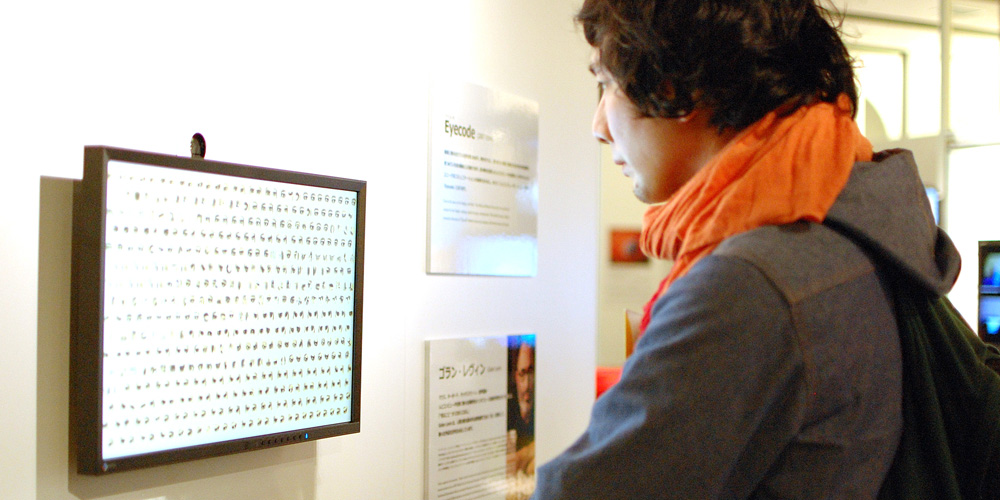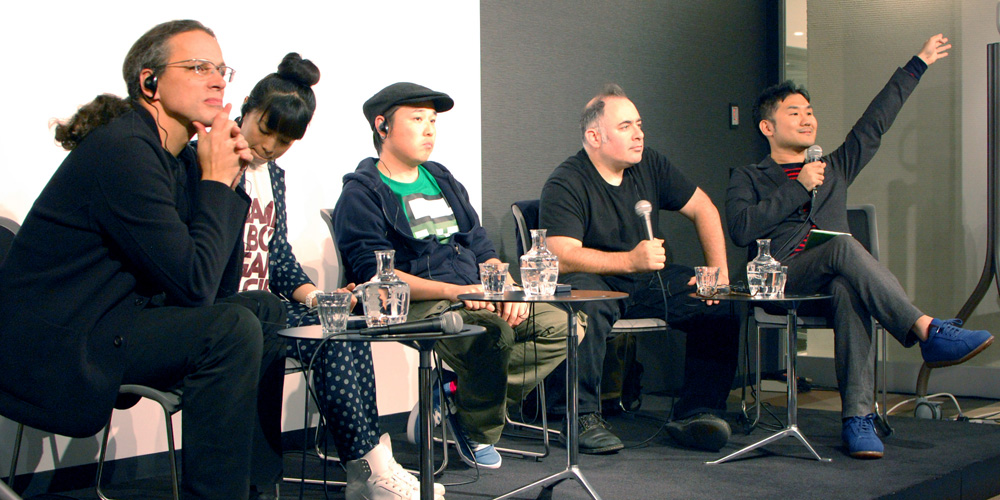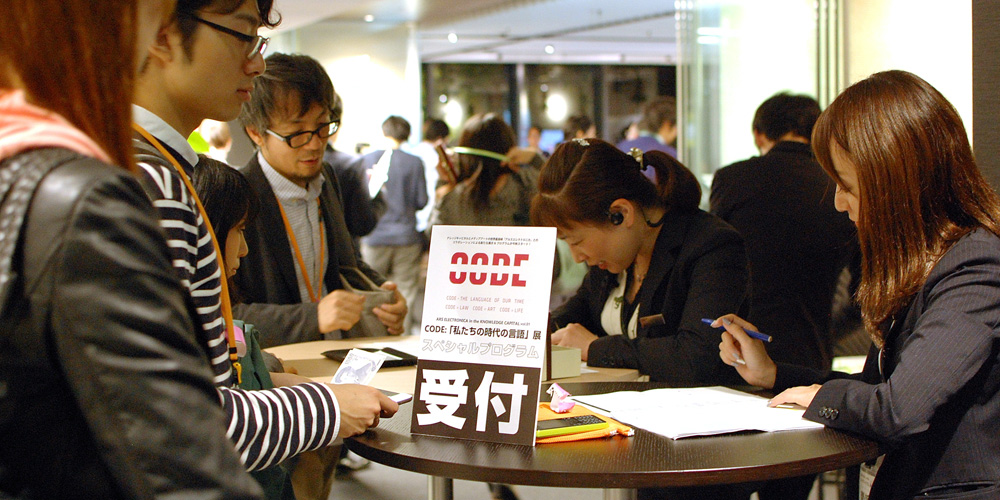
Photos: Emiko Ogawa
It’s all about to happen—men and women engaged in business as well as the creative economy are convening in the Knowledge Center in Osaka, Japan to derive inspiration from artistic perspectives. In this second installment of “Ars Electronica in the Knowledge Capital,” the theme is “Hybrid” and the formats include exhibitions, speeches and workshops. We had a chance to sit down with the producers, Ars Electronica’s Emiko and Hideaki Ogawa, to get their reaction to last November’s CODE-themed event, and find out how participants there reacted to examples introduced by artist Golan Levin.
What happened during the first days of „Ars Electronica in the Knowledge Capital“ at Osaka last November?
Hideaki Ogawa: At the first day we opened a new exhibition under the theme „Code – the language of our time“ at „The Lab“ which is part of the Knowledge Capital Osaka. After introducing the artists Golan Levin and Exonemo as well as Prix Ars Electronica itself we started to make dialogues between Osaka people and the artists. Our main focus was to formulate the network hub between them in the Knowledge Capital. The second day was an intensive talk session at the Knowledge Salon. This contained a lecture by Gerfried Stocker about „Code” and the historical shift of meaning of the code. Both artists continued to talk about their views.

What are the distinctive characteristics of the artists Golan Levin and Exonemo?
Hideaki Ogawa: Golan Levin, the magician of the code, turned his attention to poem computing and talked about a new kind of expression with code. In his lastest artwork Eidola he focussed on the human eyes. The title references to the Greek conception that eyes have the power to send out and retrieve beams – an input and output device for the human being. Even my blinking is one kind of my special and natural personal code. Golan Levin made an eternal code of eyes watching an artwork with their eyes. The visitors were becoming part of the artwork with their eyes and the story itself.

By contrast the artists group Exonemo, the hackers of code, created questions of how the code is generating the direction of our society and how artists can intervene and take actions. They developed this Captcha t-shirt that can decoded only by humans. Their Internet black market is a kind of statement of forming a creative community for discussion about the regulation of the Internet now. Both are all about activism and they are both using code as artists in a very analogue way.
After the presentations there was a very interesting discussion of how code was changed and the shift of meaning of code. They raised the questions: What can you write in code? What cannot be written in code? In this way we had many philosophical discussions. At the final day there was a workshop with Golan Levin and Emiko Ogawa from Ars Electronica.

What did you do during the workshops at the Knowledge Capital?
Emiko Ogawa: The title of the workshop with Golan Levin was called „Thinking Logically and Casually“. He introduced us to computational thinking and set out several games. For example, he gave every participant a very simple rule: Everyone had one command like „select a person in the middle of the room and follow him or her” – a very simple rule gave us a dynamic forming of the crowd. In this way he started to explain that society consists of small parts commands.

What impression did you get during the workshop?
Emiko Ogawa: It was so exciting for me. We opened the workshop for the members of the Salon who normally don’t care about art but more about business aspects. There were many different kind of persons – one worked at a medical company, one for a real estate and so on. Golan Levins workshop was computational thinking but with real experience.

The participants got inspired by the artistic way of thinking. Golan Levin mentioned the beautiful swarm of the birds or fishes. We usually don’t think that they or somebody controls the movement. The beautiful swarm consists of some very simple codes, he broke it down very clearly. Another example: Everybody had a number and the command to follow the next person with one higher number. At the end we really saw beautiful lines that anybody didn’t expect. We were also inspired that it is not only the mathematic area also these beautiful things are part of the nature. It was about connecting our body and the world as well.
For the individual it is such a simple code but from the collective view it shows the beauty.

You’ve said that the workshop was arranged for members of the Salon at the Knowledge Capital Osaka…
Hideaki Ogawa: The participants of this workshop were innovators and businessmen who were members of the Salon which is part of the facility of the Knowledge Center in Osaka – beside it there are theaters, exhibition showcases, and event spaces in this building. The Salon is like an open office for single entrepreneurs. Around this creative platform there is a shopping mall which closeness to art is very unique.
https://youtube.com/watch?v=ZspTE4XxDHk
Emiko Ogawa: The exhibition „CODE“ at the Lab was open for everybody and the area is easily accessible from Osaka train station where 2.5 million people are passing every day. Don’t forget the offices and students around. The Salon has the philosophy that it is a salon for every person from any field and offers unexpected encounters between them. It’s very interesting that they are using a slightly different concept of the infotrainers like you see it at the Ars Electronica Center Linz. They call them „communicators”, they are at the Salon. Let’s say, if you are a dentist but you are recently interested in the field of art, then you can tell it to these communicators. They write all your wishes down like a concierge and put it together with your skills into a database. These interests are only visible for the communicators themselves who try to connect different Salon members with different backgrounds personally.

Hideaki Ogawa: It’s a huge challenge trying to connect each other. But the Knowledge Salon knows that these creative industry people need these encounters to discover new innovations and new ideas. This is the future way of work. The collaboration between the Knowledge Capital and Ars Electronica exists since 2004 and Ars Electronica helped to build up this place with its experience. Both institutions have fundamental common senses. To be honest, from this place we can study a lot about relationships between many different areas.
How do you continue?
Hideaki Ogawa: The next date will be the January 29, 2015. Again there will be three days of exhibition opening, talks and workshops. The theme will be „Hybrid” like the Festival Ars Electronica 2005 where we have invited artists like Oron Catts as well as Shiho Fukuhara, Georg Tremmel and Yuki Yoshioka (BCL). We are pretty happy to have this seasonal variety here in Osaka – Code was the „autumn” program, „Hybrid“ will be the winter program.

Hideaki Ogawa (JP) is an artist, curator, and researcher in the field of art, technology and society. He is a representative and artistic director of the media artist group “h.o”, www.howeb.org. Currently he also works in the Ars Electronica Futurelab and has realized many projects for research, festivals and the Ars Electronica Center.

Emiko Ogawa (JP) is an artist, curator and researcher. She is in charge of creative direction, graphics and interaction design in the media art group “h.o”, www.howeb.org. Currently she also works at Ars Electronica and is responsible for the Prix Ars Electronica, planning the exhibitions for the Ars Electronica Center and Ars Electronica Festival.
